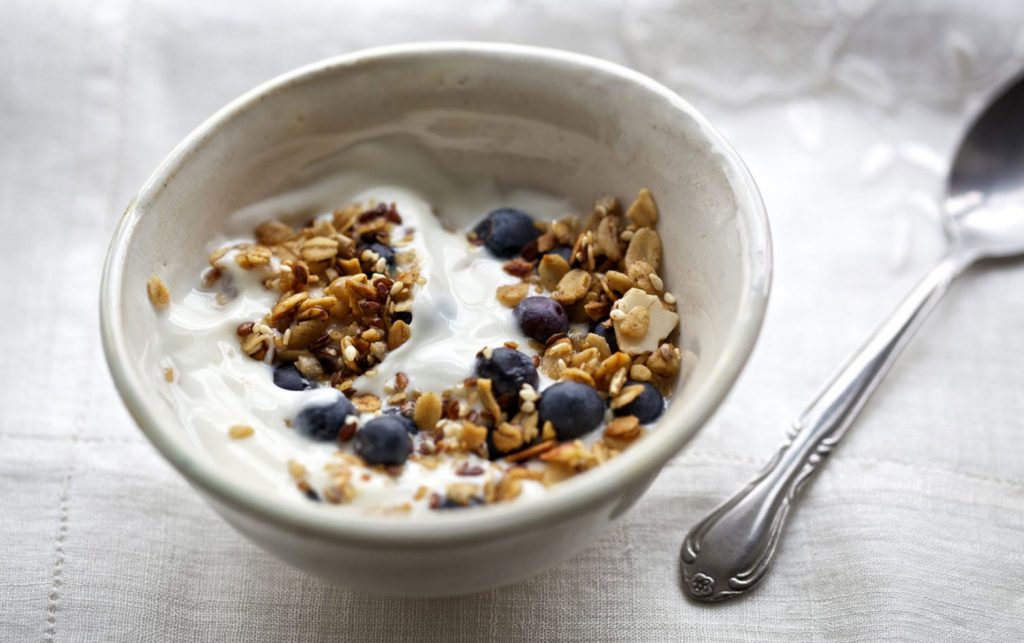
Like cereal in its day, yogurt has transformed the dairy aisle. Once relegated to a shelf or two, yogurt now comes in so many varieties the aisle has swollen to accommodate its popularity. And this is good news, both for those who embrace yogurt for health reasons and those who value its versatility.
Yogurt with fat is better for us — with less sugar than low-fat yogurt — and it’s friendlier to our waistlines and more flexible in cooking. The fact that it contains wide-ranging nutrients — protein, calcium, B vitamins, vitamin D, potassium, phosphorus, magnesium and zinc, as well as plentiful “good” bacteria — further incentivizes us to give yogurt the attention it deserves.
Here are four different factors that might influence your yogurt-buying decisions:
1. FAT
Until a few years ago, low-fat and nonfat yogurts reigned supreme in U.S. supermarkets. Fat-phobia among health professionals and consumers meant consumer demand for fuller-fat options was slim to none. Unfortunately, with fat off the label (and out of the cup), carbs filled the void. Those who reached for high-sugar — but fat-free — yogurts thinking they were making a diet-friendly choice were doing anything but.
Today, our understanding of dietary fat is more nuanced. Some fats (like transfats) have no place in a healthy diet. But the moderate saturated fat found in whole-milk yogurt is no longer demonized. Fat provides satiety — a feeling of fullness — and replacing fat with carbs does nothing to curb obesity.
2. MILK TYPES
In addition to fat, you can also choose the milk type beyond that which comes from the cow.
- Sheep milk has more milk solids, so sheep yogurt has extra body even without straining.
- Goat milk is more delicate, with a looser, runnier set.
- Non-dairy options have expanded to include cultured cups based on milks from coconut, almond and, of course, soy.
READ MORE > HOW TO CHOOSE A HEALTHIER YOGURT
3. FLAVORS
Step aside, vanilla and strawberry. Today, look for Persian yogurts (like White Moustache of Red Hook, New York), in flavors like date, sour cherry and quince; Indian yogurts (like Prayani out of Hart, Michigan), in carrot with cumin and coriander or cucumber with mint and cilantro; and Icelandic yogurts (like Icelandic Provisions), which combines blueberry with bilberries, peach with cloudberries and strawberry with lingonberries — Nordic fruits you’d be hard-pressed to find in the produce aisle.
4. ORIGIN
By now we’re all aware of Greek yogurt, the thickened, strained yogurt whose whey has been drained. A greater concentration of milk solids with a higher proportion of protein is left behind. Icelandic skyr, which is also thick and dense, tends to be higher in protein as well.
Those who want to maximize their calcium, take note: much of the calcium in yogurt resides in the whey. Toss the whey and you toss a good deal of calcium.
Perhaps consider Bulgarian yogurt (lactobacillus Bulgaricus, one of the key bacteria in yogurt, is named for that country) or yogurt marketed as “European-style.” These varieties tend to be less thick than Greek because the whey remains inside. (Any unstrained yogurt, unless artificially thickened, should retain its whey.)
Then there’s Australian yogurt. Creamy and luscious, this indulgent style is popular for dessert, though those looking to it as a diet-friendly choice should pay close attention to the sugar grams, which can soar depending on the flavor and brand.
READ MORE > THE TRUTH ABOUT GREEK YOGURT
With so many yogurt options available, it’s easier than ever to find one you love that’s truly healthful. With sugar-bomb yogurt so common, read labels closely — especially if you’re watching your waistline. Or do like I do: Stick with a high-quality, whole-milk plain yogurt. Add any sweetener, as well as fresh fruit, herbs, vegetables, nuts and more at home.
The post How to Win the Yogurt Aisle appeared first on Under Armour.
(via MyFitnessPal Blog)





